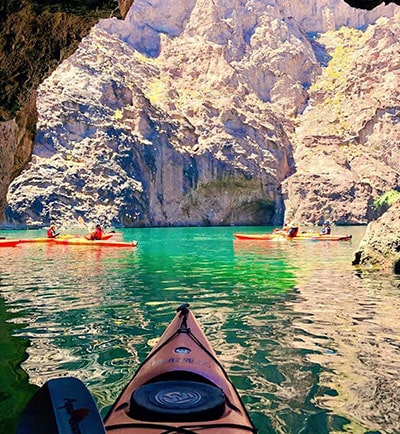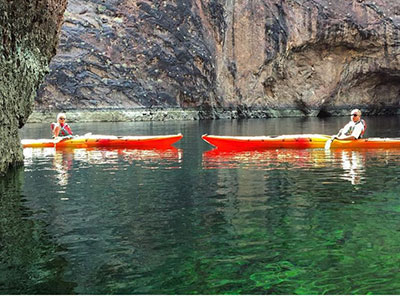Learn to Kayak: Guide to Different Kayaking Strokes
Learning to kayak in Las Vegas is a rewarding and enriching experience. After all, you’ll get in shape, explore fantastic sights, and even make new friends along the way. As with other sports, learning to kayak takes some training. There are some technicalities to master if you want to be a pro on the water, which includes learning the different types of strokes that kayakers use.
Get a Grip
Before you learn the different types of strokes required for kayaking, you will want to learn the correct way to grip the paddle. There are two types of grips that kayakers use, which are called “low-hold” and “high-hold.” A low-hold grip is the type of grip you’ll use for propelling the boat forward and maneuvering. A high-hold grip is used to avoid capsizing the boat, rolling, steering, and other more advanced techniques. Both grips can be used to move the boat forward or backward.
Forward Stroke
The forward stroke is the stroke that you will use most often when kayaking. Therefore, you’ll want to practice this stroke frequently to become comfortable and familiar with it. When you are using the forward stroke correctly, the nose of the boat, which is the front of the boat, will have minimal movement. The type of boat that you use may make it easier or more difficult to control the nose with a forward stroke. Either way, having proper technique is helpful.
There are three phases to the forward stroke, which are:
- Reach
- Power
- Alternating Side
 During the reach phase, you will use your torso, or core, to reach forward with the paddle to about the level of your feet. Dip the blade into the water on the same side so that the blade is about three-quarters of the way in the water.
During the reach phase, you will use your torso, or core, to reach forward with the paddle to about the level of your feet. Dip the blade into the water on the same side so that the blade is about three-quarters of the way in the water.
The power phase is next. Using your back, keep the shaft parallel to the boat as you draw the blade in a straight line smoothly back towards the bow, parallel to your body. The blade shouldn’t make any splashes.
Lastly, when you complete the stroke, lift the blade out of the water and place it back in the water on the other side of the boat. Repeat the process on the other side.
Over time, you will learn to repeat the alternating stroke faster and more efficiently. As you are building your forward stroke skills, make your strokes as smooth as possible and avoid excess movement in the front of the boat. Also, remember to use your torso for the stroke movements rather than your arms. Ultimately, you should be able to use the forward stroke comfortably for even a day-long Colorado River kayaking adventure.
Reverse Stroke
The reverse stroke, as the name implies, is used to help move the boat backward. The reverse stroke is generally a short and fast stroke used to respond to a tight situation, such as if you need to reverse your boat quickly for any reason. To perform this stroke, turn your body clockwise so that you are facing to the right-hand side and your shoulders line up parallel with the boat. Then, dip the blade into the water towards the back of the boat. Push the paddle forward and away from the boat. The blade should face the kayak’s side. Finally, pull the paddle towards the boat, which brings the paddle and kayak closer together. The blade should ultimately end up a few inches from the boat. Pull the paddle towards the back of the kayak and repeat the stroke as needed.
Forward Sweep Stroke
The forward sweep stroke is a stroke that’s used to move the boat sideways when you are paddling in a straight line. For this stroke, turn the paddle horizontally and put the blade in the water on the opposite side of your boat from the direction you intend to turn. Then, move the blade in a “C” shape from the tip of the boat to the rear, creating an arc shape as you go. Once the paddle has reached the end of the boat, pull the blade out of the water quickly and repeat the stroke on the opposite side of the boat. Repeat the steps of the forward sweep stroke until the boat has turned in the direction that you want to go.
Reverse Sweep Stroke
The reverse sweep stroke is similar to the forward sweep stroke, but you’ll use it to turn your kayak to the side as you are moving backward rather than forwards. To start, move the paddle over the side of your boat in a horizontal position. Dip the paddle blade into the water on the side of the boat in the direction you aim to turn. Push the paddle’s blade from the rear of the kayak to the nose. As with the forward sweep stroke, pull the blade rapidly out of the water until you have fully turned in the direction you want to turn.
Kayak Spin
 The kayak spin is a stroke used to turn the boat around when you are otherwise sitting in stationary water. This stroke uses a combination of the front sweep stroke and reverse sweep stroke. Start with the forward sweep stroke, and then switch to the reverse sweep stroke to move the boat in a circle. Repeat both strokes as often as necessary to spin your kayak in a full circle or your desired direction.
The kayak spin is a stroke used to turn the boat around when you are otherwise sitting in stationary water. This stroke uses a combination of the front sweep stroke and reverse sweep stroke. Start with the forward sweep stroke, and then switch to the reverse sweep stroke to move the boat in a circle. Repeat both strokes as often as necessary to spin your kayak in a full circle or your desired direction.
Learning to paddle a kayak correctly takes practice and patience, but it is nonetheless a rewarding experience. Practicing your paddling skills is the best way to learn and continue improving. If you want to know “where can I kayak near me?”, contact Blazin’ Paddles for more information. Blazin’ Paddles offers full-day and half-day tours for kayakers of all skill levels and ages. Even if you are just learning the sport, you can get the hang of paddling through a scenic outing such as the Black Canyon kayaking tour. All tours are led by experienced guides who can help you improve along the way.
